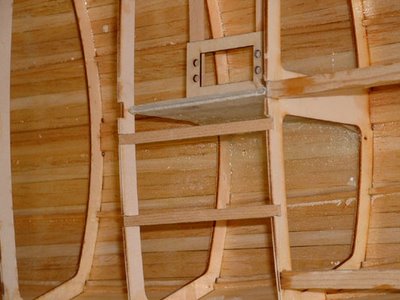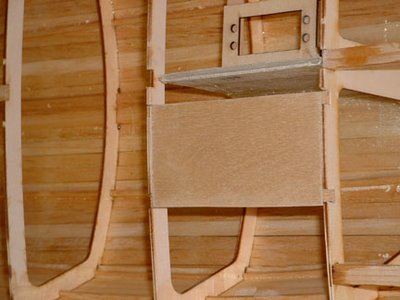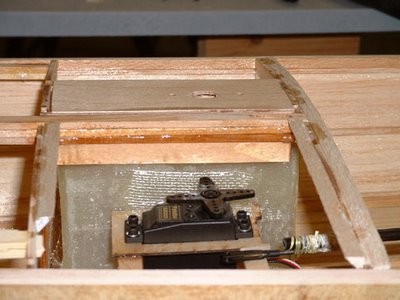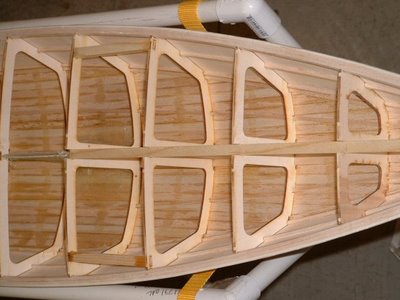Boat Plans For A Chesapeake Deadrise
Along with no ice on the boat roof, and a break in the weather, I decided to install the mast. Unlike most things boat building, this particular phase of the project actually went fairly smooth and took about as long as I figured. Getting all the parts and gear loaded on the truck took as much time as the actual installation.
.jpg)
I dont know what the mast weighs, but Id have to guess around 150 lbs. Getting it up on top of the boat was a simple matter of leaning it against the boat above the swim platform and with me on top, and with my helper lifting from the bottom, we quickly had it on the roof.
.jpg) The layout work for the pins and bushings was spot on, so it was a simple matter of first installing the upper pins and bushings, heavily tack welding the bushings ( with the pins in place ), standing the mast up, then heavily tack welding the lower bushings in place. Once everything was tacked in place and I verified the pins were not in a bind, it was final welded with a stick machine.
The layout work for the pins and bushings was spot on, so it was a simple matter of first installing the upper pins and bushings, heavily tack welding the bushings ( with the pins in place ), standing the mast up, then heavily tack welding the lower bushings in place. Once everything was tacked in place and I verified the pins were not in a bind, it was final welded with a stick machine. .jpg)
If push comes to shove, a stout person probably could step the mast by himself. Once the mast is standing, its just a matter of getting the fore and aft thing just right so the bottom locking pin can be pushed home. I should probably turn a pin with a heavy chamfer on it so its self aligning and can easily be driven home while one person both holds the mast up and drives the pin home. For the sake of safety, its a two person job, but like I said, if push comes to shove, one person probably could handle it.
.jpg)
Having never really been on a boat with a mast before, once we had it welded and standing in place, it seemed ginourmous. I know 20 isnt squat when talking about sailboats and mast, but standing on my roof while looking up at the mast, it seemed to be way up there. With the mast standing unstayed, and me pushing on it, there was a little flex in the framing. The turnbuckles I used were capable of taking up 6". Pulling the cables as tight as we could by hand, then swagging the thimbles to the turnbuckle eyes left what appeared to be a decent sag in the cable. Once we had the three stay cables rigged, I was impressed by how little it took to tighten them up. I should have probably measured, but I dont think we took up more than 1 1/2" before the cables were as tight as I thought they needed to be. Id like to hear from one who knows about how tight these cables need to be, but to me they feel pretty comfy. The two shroud cables are about five degrees off of 90 degrees to the mast, so the fore stay cable pulls against the shroud cables. Shrouds are athwart-ship while stays are fore and aft. With the cables tensioned, the mast now felt rock solid.
.jpg)
Having spent the last three weeks fabricating in the shop and dry fitting everything together, getting the boom in place and rigging the electric winches took practically no time at all. Using a spare battery from the shop to temporarily electrify the winches, we were finally making things go up and down. We played around for a short time and hoisted the 200 lbs generator to the roof and back down. The winches are remote controlled, and have different frequencies, so thats going to make things easier.
.jpg)
To wrap up this project, I need to build a dedicated battery box and decide how Im going to charge the battery. All the solenoids, and fuses for the winches will go in the battery box. Ill probably build the box big enough to hold some tools slings for lifting. Im leaning towards a dedicated winch battery vs pulling heavy wires from the main distribution panel.
A wire chase is already framed from the wheel house to the mast step, so getting wires to that point will be easy. I have a 6x6 splice box already on the mast step, and this will be my transition from interior to exterior. Ill make water tight connections in the splice box and bring cord out of the splice box using cord grips. I dont think Ill be able to do this with the radar cord, so a custom split cord grip will have to be used.
%2B-%2BCopy%2B(2).jpg)
The heavy work is finished on this project and Im pretty happy with how its turned out. Im going to finalize fabricating the wiring harnesss for the winches and getting a battery box built so I can use the hoist for the hand rail build. most of the hand rail will be fabricated and welded in the shop so Ill use the boom to hoist the three sections along with holding them in place while I weld the rail to the roof. It will also be nice being able to hoist the welder to the roof. Heck I might even bring the big MIG welder down to do this job now that I can get it along with the large tank up top.
Im liking this project.
Cheers

Do you find information about Boat Plans For A Chesapeake Deadrise are you looking for? If not, below may help you find more information about the Boat Plans For A Chesapeake Deadrise. Thank you for visiting, have a great day.
.jpg)
.jpg) The mast step is already welded to the boat, and is comprised of two heavily gusseted pieces of 1/2" stainless plate welded into the heavily reinforced roof framing. The two plates have bores through them that the mast will pin in to allowing it to be easily laid down.
The mast step is already welded to the boat, and is comprised of two heavily gusseted pieces of 1/2" stainless plate welded into the heavily reinforced roof framing. The two plates have bores through them that the mast will pin in to allowing it to be easily laid down..jpg) The upper pin in the mast will bear the load, and the lower pin will be for locking it in place.
The upper pin in the mast will bear the load, and the lower pin will be for locking it in place..jpg) In order for the mast to be able to pivot, I laid it out so that there is 1.5" of free space between the bottom of the mast and the step base. Once the mast is stepped and stayed, solid blocking will be wedged between the bottom of the mast and the step base.
In order for the mast to be able to pivot, I laid it out so that there is 1.5" of free space between the bottom of the mast and the step base. Once the mast is stepped and stayed, solid blocking will be wedged between the bottom of the mast and the step base. .jpg) Because the bushings are going to be TIG welded in to the mast, I had to do a bit of compensating to allow for weld distortion. I decided to bore the bushings .006 over the pin diameter, and as luck would have it, that turned out to be the right amount. The fit is good with no tight spots and every so slight end play.
Because the bushings are going to be TIG welded in to the mast, I had to do a bit of compensating to allow for weld distortion. I decided to bore the bushings .006 over the pin diameter, and as luck would have it, that turned out to be the right amount. The fit is good with no tight spots and every so slight end play..jpg) When the pin engages both bushings, there is no side to side play. The lower pin used for locking the mast in place has no bushings welded in place.
When the pin engages both bushings, there is no side to side play. The lower pin used for locking the mast in place has no bushings welded in place..jpg)
.jpg) The winches have remote controls, so that should make things a little easier to operate. I"m not 100% sure, but to power the winches, Im going to have a battery on the roof with a small dedicated charger in the wheel house, or possibly a small solar panel to keep the winch battery fresh. Either way, the battery will be in a weather tight box along with the winch fuses and solenoids. All the winch brackets are in place along with test fitting the winches.
The winches have remote controls, so that should make things a little easier to operate. I"m not 100% sure, but to power the winches, Im going to have a battery on the roof with a small dedicated charger in the wheel house, or possibly a small solar panel to keep the winch battery fresh. Either way, the battery will be in a weather tight box along with the winch fuses and solenoids. All the winch brackets are in place along with test fitting the winches. .jpg)
.jpg)
.jpg) These types of fittings are not as nice as the single pass stainless swage fittings used on sailboat rigging, but theyre for sure in my budget and look much better than cable clamps. I did use stainless steel on the thimbles since this point will see some abrasion. Years down the road when I start doing maintenance and repairs, I hope to upgrade to all stainless.
These types of fittings are not as nice as the single pass stainless swage fittings used on sailboat rigging, but theyre for sure in my budget and look much better than cable clamps. I did use stainless steel on the thimbles since this point will see some abrasion. Years down the road when I start doing maintenance and repairs, I hope to upgrade to all stainless. .jpg)







.jpg)
.jpg)
.jpg)
.jpg)
.jpg) The leaf for the part was cut from 1/2" stainless plate and was TIG welded to the tube. Having bored the tube to a final dimension of .003 over ( the pin is 3/4") I was not surprised when the pin was not fitting well after I welded the part. Chucking the part back in the lathe to clean up the bore was expected and I ended up having to bore about .003 from the bore to get back the nice fit I had before the weld ( Im sitting here wondering how Im going to clean up the bore for the mast step bushings after that weld).
The leaf for the part was cut from 1/2" stainless plate and was TIG welded to the tube. Having bored the tube to a final dimension of .003 over ( the pin is 3/4") I was not surprised when the pin was not fitting well after I welded the part. Chucking the part back in the lathe to clean up the bore was expected and I ended up having to bore about .003 from the bore to get back the nice fit I had before the weld ( Im sitting here wondering how Im going to clean up the bore for the mast step bushings after that weld). %2B(2).jpg)
%2B(640x480).jpg)
